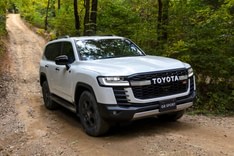Toyota India has launched a new campaign dubbed “Hum Hai Hybrid” to promote Self-charging Hybrid Electric Vehicles (SHEV) technology. What the campaign also seeks to draw attention to is the fact that this strong hybrid tech – and a big jump in fuel savings – will soon be more accessible as it will debut on SUVs like the Creta rival that Toyota is jointly developing with Maruti Suzuki.
- SHEV tech will debut on Toyota’s upcoming Creta rival (D22) midsize SUV
- Strong hybrid system will be around 30-70 percent more fuel efficient
- It can be used on pure electric power for short distances
Toyota’s upcoming Creta rival (D22) could be as fuel efficient as a hatchback
We have already seen strong hybrid systems in Toyota’s more premium offerings – the Camry sedan and Vellfire MPV. Now, a similar hybrid system is set to make its way into the new Toyota midsize SUV (codenamed D22).
The Toyota D22’s strong hybrid system is likely to be a first in the midsize SUV segment and is poised to offer fuel efficiency figures on par with a hatchback.
How does Toyota’s strong hybrid system (SHEV) work?
The strong hybrid system comprises of a petrol engine that is accompanied by a small NiMH (Nickel-metal Hydride) battery pack and a strong electric motor (hence the name strong hybrid). This system allows for a pure electric mode that solely uses the electricity to power the wheels for short distances.
The battery pack can be recharged by the engine or regenerative ‘braking’ (unlike a plug-in hybrid or PHEV that needs to be plugged into a wall charger). When the battery’s running low (or when the situation demands), the system can switch to using the petrol engine, hence removing any range anxiety typically associated with EVs. This hybrid system in many ways is similar to the one present on the recently unveiled Honda City e:HEV hybrid.
Why is strong hybrid tech useful?
Cars with the SHEV system can be driven for long stretches on electric power alone, using the combustion engine to top off the battery. Since power is mainly consumed via the battery and electric motor, the car in this mode assumes an efficiency between 90 and 95 percent.
As a result, with this hybrid set-up, the system can deliver a 40 to 80 percent jump in fuel efficiency over its non-electrified counterpart, according to Toyota. This is as per testing agency, iCAT study (IRDE cycle).
Given that this system aims to use the electric motor as frequently as it can, there is also a significant reduction in emission levels, with Toyota claiming up to 50 percent reduction in CO2 emissions over equivalent non-hybrid powertrains.




















Comments
Member Login
Personal Details
Varun Jm - 1102 days ago
Both Toyota and Suzuki should re-think of introducing diesel.